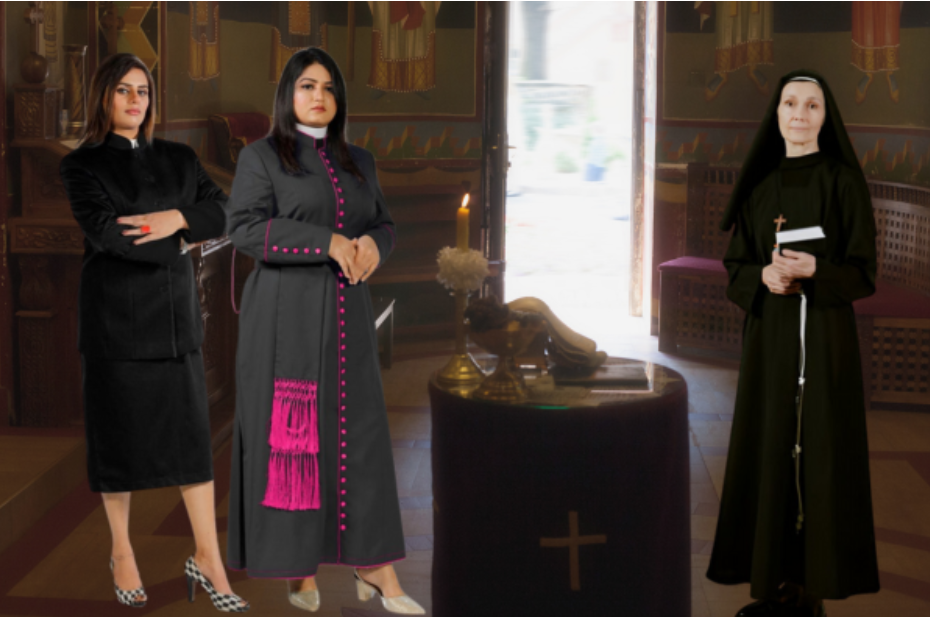Clergy attire for women is not just about tradition; it’s about professionalism, respect, and showing up in a way that aligns with your faith. Whether you’re a priest, minister, deacon, or any other position of leadership within the church, the right clergy clothing plays an important role in how you are perceived.Divinity Clergy Wear But knowing what to wear, when to wear it, and how to wear it properly can sometimes be tricky.
This article aims to guide you through the various types of clergy clothing for women, when to wear each type, who wears what, and how to wear it the right way. Whether you’re looking for clergy wear for women locally or online, we’ve got you covered with tips and advice to help you find the perfect attire.
1. Understanding Clergy Wear for Women
What is Clergy Clothing?
Clergy clothing, specifically designed for women, has a deep connection to church tradition. These garments symbolize spiritual authority and function in religious rites, serving as both practical clothing and symbols of faith. Clergy wear for women typically includes garments such as cassocks, albs, and chasubles, along with accessories like stoles and tippets.
These garments help clergy women stand out as representatives of their faith, symbolizing humility, service, and respect. The right attire also provides comfort and freedom of movement for long services, ceremonies, and daily duties.
Types of Clergy Clothing for Women
Here are the most common types of clergy wear for women:
1.1 Cassocks
Cassocks are long, floor-length robes worn by clergy members. They are typically made from dark, modest fabrics and worn for formal ceremonies or regular services. The cassock is seen as a symbol of modesty and humility.
1.2 Alb
The alb is a white, full-length garment worn by clergy during Mass, baptisms, and other liturgical events. It’s a simple yet elegant piece of clothing, typically worn under a chasuble. The alb represents purity and is often worn by both male and female clergy for its comfort and simplicity.
1.3 Chasuble
The chasuble is the outermost vestment worn over the alb, often during Eucharistic services. Chasubles come in various colors, each symbolizing different seasons or events in the church calendar, such as purple for Advent and Lent or white for major feasts like Christmas and Easter.
1.4 Clergy Dresses with Full Collar
This attire is the most common everyday garment worn by female clergy. It’s both formal and modest, typically designed with a full collar and long sleeves. These dresses come in different styles and cuts, making them versatile enough to wear for both church services and meetings.
1.5 Tippet/Stole
A tippet or stole is a decorative cloth worn around the neck. The stole is often worn during formal church ceremonies and represents the office of the clergy person. Tippets are more commonly seen in Anglican traditions, while stoles are more common in Catholic and Protestant rituals.
2. When to Wear Each Type of Clergy Attire
Clergy attire is not “one size fits all.” Different types of clothing are worn depending on the occasion, the type of service, and the role of the clergywoman. Here’s a breakdown of when to wear each type of clergy wear:
2.1 Everyday Clergy Attire
Clergy Dresses with Full Collar
For most clergy women, a clergy dress with a full collar is their go-to attire for everyday activities, whether leading worship or working behind the scenes. These dresses are versatile and perfect for daily office work, counseling sessions, and casual services. The full collar adds a professional, formal touch, while the overall design ensures comfort for day-to-day wear.
2.2 Liturgical Services
Alb, Chasuble, and Stole
When you’re participating in a liturgical service like a wedding, baptism, or the Eucharist, the alb, chasuble, and stole come into play. The alb is typically worn as the base garment, followed by the chasuble, which is the colorful outer vestment. The stole is draped over the shoulders and signifies the clergy member’s sacred role. The chasuble’s color corresponds to the liturgical season, such as purple during Advent or Easter, and white for major celebrations like Christmas.
These garments are formal, designed for religious ceremonies where respect and tradition are central.
2.3 Casual Services or Non-formal Worship
Cassock or Robe
For less formal services, like evening prayer or small group worship, a cassock or robe might be more appropriate. These garments are less elaborate than the chasuble but still offer a professional appearance suitable for a more subdued setting. They are often worn by deacons or other clergy members who aren’t presiding over the Eucharist but are still involved in worship leadership.
2.4 Special Ceremonies
Tippet or Stole
During ceremonies such as ordinations, special blessings, or other rites of passage, the tippet or stole is often worn. These decorative cloths signify the importance of the occasion and the spiritual role of the person performing the ceremony. The tippet may be worn with a cassock, while the stole is typically worn over an alb and chasuble for formal services.
3. Who Should Wear Each Type of Clergy Clothing?
Different types of clergy clothing are worn depending on the role, occasion, and personal preference of the clergy woman. Here’s a breakdown of who wears what:
3.1 Women Clergy Leaders
Women in leadership roles, such as bishops or senior pastors, typically wear more formal clergy attire, including cassocks, chasubles, and stoles. These garments help signify their authority within the church, ensuring they are distinguished during worship services and special ceremonies.
3.2 Women in Pastoral Care
Women serving in pastoral roles, including those who provide counseling, care, and outreach to the community, may prefer to wear more comfortable and modest clothing. A clergy dress with a full collar is often ideal for these roles, providing professionalism without being overly formal.
3.3 Women Preachers
Preachers and sermon leaders often wear clergy dresses with full collars or albs, depending on the liturgical tradition. The attire allows them to maintain a formal appearance while also providing comfort during lengthy services.
3.4 Support Roles
For women in support roles, such as deacons or lay ministers, more modest and practical attire may be preferred. While some may wear cassocks, others may choose simpler garments like clergy dresses or robes. These roles often call for more functional clothing that allows freedom of movement without losing the sense of reverence.
4. How to Wear Clergy Clothing Correctly
Wearing clergy attire correctly goes beyond simply putting on the right pieces. Here’s a guide to ensure you wear your clergy clothing with confidence:
4.1 Fit and Comfort
The most important aspect of clergy clothing is that it fits well and allows freedom of movement. Make sure that your cassock, alb, or clergy dress isn’t too tight or too loose, as this can be distracting during services. Proper fit also enhances comfort, especially for longer events like services, weddings, or counseling.
4.2 Layering and Accessories
Layering is key when it comes to clergy wear. If you’re wearing an alb, consider adding a chasuble on top for special occasions. A stole or tippet can add an extra layer of elegance and spirituality to your attire. Remember to choose accessories that complement your outfit, such as a simple cross necklace or a modest hat for outdoor ceremonies.
4.3 Color Choices
Color is an essential part of clergy clothing. Different colors represent different liturgical seasons and occasions. Here’s a quick breakdown:
- Purple: Advent and Lent
- White: Easter, Christmas, and major feasts
- Green: Ordinary time
- Red: Pentecost and feasts of martyrs
- Black: Funerals and solemn occasions
Ensure you wear the right color for the season or event to maintain the spiritual significance of your attire.
4.4 Proper Maintenance
Clergy wear requires special care to maintain its appearance and longevity. Make sure to follow the care instructions for each garment, especially when it comes to delicate fabrics like silk. Regularly clean and iron your cassocks, albs, and clergy dresses to ensure they remain crisp and professional.
5. Finding Clergy Attire Near Me
5.1 Where to Purchase Clergy Clothing for Women
Finding clergy wear for women can be challenging, but several reputable retailers provide high-quality, affordable options. Look for stores that specialize in religious clothing and accessories. You can find both online and local stores that offer clergy wear for women in different sizes, styles, and materials.
Some trusted online retailers include:
- eClergy.com: Offers a variety of clergy attire for women, including dresses, cassocks, and accessories.
5.2 Online vs. Local Stores
If you’re wondering whether to buy clergy wear for women online or locally, both options have their benefits:
- Online Stores: Offer a broader selection and more customization options, often with free shipping.
- Local Stores: Allow you to try on the garments, ensuring the perfect fit and comfort.
If you’re searching for “clergy attire near me,” consider visiting local stores to see and feel the fabric before making a purchase. You can also find a personal shopper who can guide you in choosing the best options.
6. Common Mistakes to Avoid with Clergy Wear for Women
6.1 Ill-Fitting Garments
Clergy wear that is too tight or too loose can be uncomfortable and distracting. Ensure your attire fits properly and allows for ease of movement during services.
6.2 Neglecting Comfort for Fashion
While clergy clothing should be respectful and professional, it’s important not to sacrifice comfort for style. Always prioritize comfort, especially for long services or daily wear.
6.3 Wearing Inappropriate Colors or Styles for the Occasion
Wearing the wrong color for the season or event can undermine the spiritual significance of your attire. Stick to the appropriate colors for the occasion to maintain the right tone.
6.4 Over-Accessorizing
While accessories can add elegance to clergy attire, too many accessories can detract from the overall look. Keep your accessories simple and meaningful.
Conclusion
Clergy clothing for women plays a vital role in how we present ourselves in our faith communities. The right attire signifies respect, professionalism, and spiritual authority, while also ensuring comfort during long services and ceremonies. Whether you’re looking for a clergy dress with a full collar, a cassock, or a chasuble, understanding when and how to wear these garments is key to doing so confidently.
Remember to choose the right attire for your role and occasion, and take care of your garments to ensure they last for years to come. If you’re on the hunt for “clergy attire near me,” consider visiting local shops, or browse online retailers like eClergy.com for a great selection.
By following these tips, you’ll be able to wear your clergy attire with grace, respect, and confidence every day.





